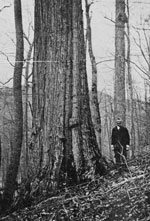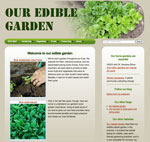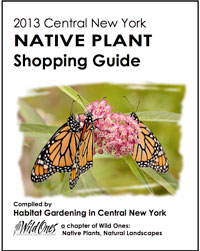Invasive Species Workshop
Tues., Oct. 8
9 am - 4 pm
|
 | | Japanese knotweed |
|
Experts will address these topics: 1. Impacts of Invasive Species on American Hart's Tongue Fern 2. White-tailed Deer and Their Impacts to Forest Ecosystems and the Spread of Invasive Species. 3. The Kettle Lakes of Cortland and Onondaga Counties Anthropogenic Influences on Aquatic Invasions 4. Legislative Action for Addressing Impacts from Invasive Species in NYS 5. Shifting Ecologies of Vector- borne Diseases: Novel Emergence, Recent Resurgence, and the Usual Suspects. 6. Perspectives of Climate Change on Invasives Sponsored by the Sisters of St. Francis, held at Alverna Heights in Fayetteville. For more info and to register, download the brochure at http://alvernaheights.org/
|
Return of the King: Restoring the American Chestnut
Thurs., Oct. 10
|
 | | American chestnut |
|
The American chestnut tree was one of the most abundant and important trees in the eastern forests before it was devastated a century ago by chestnut blight. American chestnut trees with enhanced blight resistance have been developed using the tools of biotechnology. This free lecture by Dr. William Powell will discuss this step in returning this king of the forest. Free and open to the public.
Thurs., Oct. 10 7:30 pm Gateway Center,
SUNY ESF
Parking is available on campus. (Download temporary parking permit at www.esf.edu/rwls .) For more info, contact the Roosevelt Wild Life Station, 315-470-6762 or visit www.esf.edu/rwls
|
Onondaga Lake Conservation Corps
Sat. Oct. 19,
9 am-noon
|  |
Join the team of volunteers planting native plants to help transform Nine Mile Creek. In addition to planting, you'll learn from experts from the Montezuma Audubon Center, Onondaga Audubon Society, and others. Help transform 30 acres to create a healthy Onondaga Lake watershed. Space is limited. Registration is first come, first served. RSVP to the Montezuma Audubon Center at montezuma@audubon.org with the subject line "Onondaga Lake" or call 315-365-3588 by Oct. 10.
|
Preserving Water Quality in a Changing Climate
Oct. 26
8 am - 2 pm
| |
| |
The Symposium will feature local experts discussing invasive species, water quality, sustainable landscapes, adapting agriculture to a changing climate and sustainable regional planning.
A Keynote address will be given by Meteorologist Dave Eichorn.
Registration is $25 and includes lunch. It will take place at The Lodge at WelchAllyn in Skaneateles Falls.
Sponsored by Cornell Cooperative Extension
Agenda, registration and directions can be found on the CCE website.
|
| Our Habitat Garden |  |
Visit Our Habitat Garden website for information on providing habitat, earth-friendly gardening practices, plants, and various creatures here in Central New York.
|
HGCNY Officers
| |
| President:
Janet Allen
Vice-President:
Carol Biesemeyer
Treasurer:
Randi Starmer
Secretary:
Soule Leiter
Membership:
Linda Rossiter
Program Chair:
Carol Biesemeyer
Newsletter Editor:
Janet Allen
Additional Planning Committee Members:
Beth Mitchell
Dave Mitchell
John Allen
|
| HGCNY on Facebook |
As as more of us participate on our Facebook page, this will become a useful resource for asking (and answering!) local HGCNYers' questions about habitat gardening. |
|
Join HGCNY!
|  |
Becoming an official member of HGCNY is easy: just join Wild Ones! Basic household membership is $37/year, but there are other options, too. (See membership application or website.)
Wild Ones
P.O. Box 1274
Appleton, Wisconsin 54912-1274
Make checks payable to Wild Ones.
Or telephone toll-free 877-394-9453.
|
|
Our Edible Garden
|  | Visit OurEdibleGarden.org to see an example of a Central New York edible garden, the perfect companion to your habitat garden.
|
|
 | | Juniper |
Our October 27 program will help you enjoy winter more!
We're pleased to again have Joe McMullen, Environmental Consultant, as our speaker. He'll give us tips on how to identify plants in winter when they don't have their leaves or flowers.
We meet at Liverpool Public Library on the last Sunday of the month at 2:00 pm. Free and open to the public. Invite a friend! ( Directions) Save the dates for upcoming programsNov. 24 ( NOT Thanksgiving weekend this year!): Jessi Lyons, Cooperative Extension natural resource educator, will discuss the Emerald Ash Borer, which has arrived in our area. (No meeting in December.)
Janet Allen
President, HGCNY
|
|
|
Bringing back the American chestnut
 | |
ACCF field trial of blight-resistant American chestnut, 100% genetically Castanea dentata.
(Photo: Wikimedia Commons - jaknouse)
|
Before chestnut blight was introduced on imported Asiatic chestnut trees, the American chestnut (Castanea dentata), native to eastern North America, was one of the most common -- and most important -- trees throughout its range.
A large tree, it reached almost 100 feet tall and was about 10 feet in diameter. It ranged from Maine to Mississippi, and made up a quarter of the trees in the Appalachian mountains!
As the American Chestnut Foundation says, "In those thousands of years preceding the blight's arrival, an enormously complex set of relationships evolved which tied the chestnut to innumerable bird, mammal, and insect species and other organisms, as well as to rocks, water, soils and fires. Essentially, chestnut was tied to the very shape of the hills and mountains on which the trees were found."
The blight destroyed billions of chestnut trees in the first half of the twentieth century. Since then, a variety of efforts to restore the chestnut have been underway.
Some of the methods being explored:
The American Chestnut Cooperators' Foundation (www.accf-online.org/) is using only pure American chestnut genetic stock to create blight-resistant trees, along with biological control measures in the forest environment.
The American Chestnut Foundation (www.acf.org) is introducing into the American chestnut the genetic material responsible for the blight resistance of the Chinese tree, and at the same time, preserving in every other way the genetic heritage of the American species.
The Northern Nut Growers Association has been pursuing hybrids with Chinese varieties.
SUNY-ESF's American Chestnut Research and Restoration Project (www.esf.edu/chestnut/) is creating trees that are genetically modified to resist the fungus, and could be the first GM forest trees released in the wild in the US. (Note free lecture in the left sidebar.)
More than chestnuts
The success of these strategies could have important implications for other native trees in trouble, such as the American elm (afflicted by Dutch elm disease), the hemlock (afflicted by the wooly adelgid), and now our ash trees (afflicted by the emerald ash borer).
|
|
American chestnut, American tragedy
 | |
Photo: Wikimedia Commons
by Peatcher
|
"The blight that has caused the near extinction of the American chestnut ranks, in my opinion, as the single greatest catastrophe that has befallen the eastern broadleaf forests since the arrival of Europeans nearly 400 years ago. It is an epic tragedy not only because the tree was so important to myriad animals and insects, as well as to indigenous people, but also because this magnificent tree -- so supremely adapted to life in the humid temperate forest -- was struck down by a disease we humans undeniably aided and abetted. ... I still hold out hope -- buoyed by the fierce tenacity of millions of resprouting chestnut roots -- that somehow, someday, this majestic tree can beat the disease and take its former place in our forests. I hope I live to see that -- nothing could make me happier." Each of Cullina's plant descriptions in the book has a "USES" section. He lists this USE for chestnut: "As a reminder of the importance of persevering in the face of terrible odds."
~ William Cullina, author of Native Trees, Shrubs, & Vines, pp. 72-73
|
|
The Man Who Planted Trees

The Man Who Planted Trees by French author Jean Giono tells the story of one man's singlehanded effort to re-forest a desolate valley in the foothills of the Alps in the first half of the 20th century. This inspiring, though fictional, story has been adapted as animated shorts, for puppets and so on. (A WikiSource text-only version is available online, but see the animated movie if you can.)
From fiction to real life
These real people have made a difference for the natural world and for people by planting trees:
Wangari Maathai - founded the Green Belt movement in Kenya, which helped women plant millions of trees to combat desertification, deforestation, water crises, and rural hunger.
Jadav "Molai" Payeng - over the course of several decades, has planted and tended trees on a sandbar of the river Brahmaputra in India turning it into a forest reserve encompassing 1,360 hectares.
Trees for the Future - a Maryland-based nonprofit organization helps communities around the world plant trees. So far, they've planted 65 million trees worldwide in 30 countries.
Shanghai Roots & Shoots - a division of the Jane Goodall Institute, launched The Million Tree Project in Inner Mongolia to plant one million trees to stop desertification and alleviate global warming.
What we can do
If you look around most neighborhoods, you'll see large, often native, trees being replaced by smaller, "ornamental," generally non-native trees. What a loss for our neighborhoods, for wildlife, and for the planet! Let's all plant native trees wherever and whenever we can!
"When is the best time to plant a tree? Twenty years ago. The second best time? Today."
~ Chinese proverb
|
|
Protecting plants from deer
 One of our members, Estelle Hahn, has invented an almost invisible deer-resistant fencing system that protects young plants until they're established. One of our members, Estelle Hahn, has invented an almost invisible deer-resistant fencing system that protects young plants until they're established. She installed 6' tall thin green plastic stakes at the edge of the planting bed every 10' or so. She then attached a series of three 24-gauge steel galvanized wires at the ends of the beds, wrapping them around the stakes in between.  Estelle notes that deer can easily jump a 6' fence, but there are two good reasons why they won't do it with this system in this location: Estelle notes that deer can easily jump a 6' fence, but there are two good reasons why they won't do it with this system in this location: 1) they probably can't see the wires and don't know what or where they are, and 2) the beds are too close to the house for them to consider jumping in that direction. It has worked for her, and if you have similar situation, it might work for you, too! |
|
|
Native Plant Shopping Guide
 | | Click image to download the Guide |
Are you looking for native plants in general or a particular native plant?
Chances are you can find them somewhere in CNY.
Our 2013 Native Plant Shopping Guide shows you where. You're welcome to download it by clicking on the image to the right, OR you can download it from our website homepage (midway down the page). It's free!
As always, we recommend that you call ahead if you're looking for a particular plant. Some less common native plants may be in short supply, and you wouldn't want to waste a trip to find that your plant had sold out. |
|
|